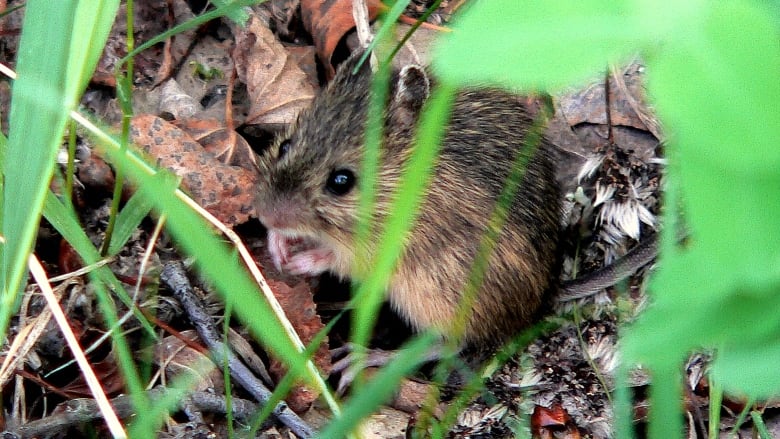They scurry, climb and chew, but have you heard of jumping mice?
Naturalist Brian Keating discusses one of Albertas little known species

They're small, they're springy and apparentlythey make a good snack for great blue herons.
Jumping mice are one of Alberta's little known species, according to Calgarynaturalist Brian Keating, but he hasn't caught many of them on film.
But recentlyphotographer Susan Ingham who owns Ingham Nature Photography Inc. sent him a collection of photos showing a mouse heading straight down a bird's gullet at Fish Creek Provincial Park in south Calgary.
"She was really unsure of what kind of rodent it was, and she thought maybe it was a baby muskrat," Keating said in an interview on The Homestretch.
He sent the photo to professional biologist Chris Fisher, whoimmediately wrote back to say its long tail and "long hind limbs and the yellowish undersides points to a jumping mouse."

Most often, we hear about the house mouse, the white-footed mouse and the meadow vole, which is often called a field mouse, but there are many different types of rodents out there, Keating says.
During his time working with the Canadian Wildlife Service in Saskatchewan, they would set traps baited with peanut butter in order to conduct small mammal studies.
"I was completely blown away by the diversity out there. Every morning was like Christmas with sometimes new species found," he said.
According to the Alberta government, there are seven species of mice in the province and 12 species of voles, which are small rodents with very short tails, Keating says.
He hasalso been particularly interested in the kangaroo mouse, which is a species of jumping mouse specific tosand dune areas in the prairies, such as spots close toCanadian Forces Base Suffield near Medicine Hat.
These latest photos indicate jumping mice are found around Calgary, too.
"It's just a very cool concept and a seldom seen rodent that can be identified as it's heading, head first, down the gullet of a serious predator!"
Why mice jump
In the case of the kangaroo mouse, Keating says jumping is actually a very efficient way to travel across sandy environments.
"If you look at the real kangaroos of Australia, studies have shown that their bounding jump actually consumes less energy for the distance covered," he said.
"It creates less muscle heat, which is a good adaptation when you think about it with an environment that has limited water and is often hot."
Jumping mice are also found in wet, marshy areas, where a jump would also be an efficient mode of getting around, Keating says.
There are two kinds of jumping mice most commonly found in Alberta:the meadow jumping mouse, found in the northern part of the province, and the western jumping mouse, found in the southern part.
They can jump about two feet in distance and one foot high.
"Apparently their usual hop is similar to a hopping frog," Keating said.
The rodents typically spend about nine months in hibernation, emerging in late May having lost almost 25 per cent of their body weight.
Females have a 19-day gestation period before delivering up to nine young.
They become a potential meal for heron, since the birds are "opportunistic hunters," Keating says, and will eat anything of swallowable size, including fish, frogs, reptiles, small mammals, insectsand other birds.
"They grab smaller prey in their strong mandibles and they can also use their dagger-like bills to impale larger fish," he said.
"They've got a very specialized elongated vertebrae in their neck that enables them to strike at the prey with a remarkable amount of force."
If the jumping mice don't get eaten, they live up to four years, Keating says.
"How incredibly exciting to find out that here in Calgary, and throughout Alberta, there's another jumping mouse species out there."
For more fascinating stories about Alberta's wildlife from naturalist Brian Keating,visit his websiteand check out these stories:












_(720p).jpg)


 OFFICIAL HD MUSIC VIDEO.jpg)
.jpg)



























































































